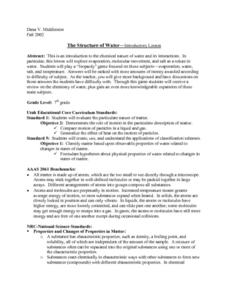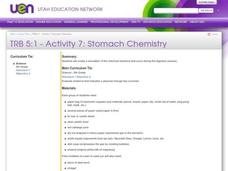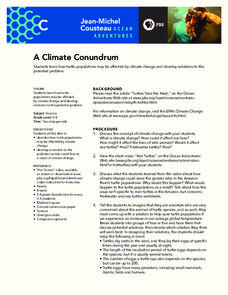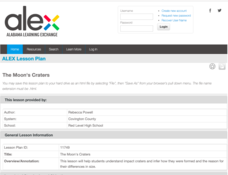Curated OER
What Is the Freezing Point?
Students remove heat energy and determine how it causes a phase change.
Curated OER
Chemical Equilibrium
In this chemical equilibrium worksheet, students work with the LeChatelier's Principle to determine the effects of changes in concentration or partial pressure and the effect of changes in total pressure or volume. This worksheet has 9...
Curated OER
The Chemical Nature of Water
Seventh graders simulate a Jeopardy game to examine the chemical nature of water. Among the topics featured are evaporation, water, salt, and temperature. finally, as review, 7th graders answer a battery of questions presented by the...
Curated OER
What Makes you Hot?
Learners manipulate different variables in a model and make inferences about the temperature on Earth. In this heat lesson students calculate the blackbody radiation of an object at a certain temperature.
Curated OER
Solar S'Mores
Students see that solar energy is the energy given off by the sun. They explain that when light energy is absorbed by objects it is changed to heat energy and that dark-colored objects absorb more light and store more heat from sunlight.
Curated OER
The Causes of Differences in Density
Students explore how density changes. Students read an article on density. They observe a ball and ring demonstration and discuss the outcome. Students draw models of the demonstration and explain what happened.
Curated OER
Melting Ice
Pupils observe the melting of ice and explore the basic physical changes that occur. They gain information of how different substances change the rate of melting. Students discuss the properties of water and ice, the definition of...
Curated OER
Microbe Experimentation: Sour Milk
Sixth graders design and conduct an experiment with milk to investigate how temperature affects bacteria growth. They, in groups, construct a hypothesis, perform the experiment and then record and present the results.
Curated OER
How Does a Liquid Become a Solid?
Students explore the energy changes from a liquid to a solid. They model the arrangement of a solid and the change in states due to changes in energy using desks and chairs. Assessment questions are provided in lesson plan.
Curated OER
How Do You Dew?
Students examine how the processes of condensation and evaporation occur. They describe the relationship between heat energy, evaporation and condensation of water on Earth. They give examples of the processes of evaporation and...
Curated OER
Air Masses
Learners are given maps depicting two or more air masses and they then categorize bodies of air by temperature and moisture characteristics. They recognize large regions of similar type air. Students are given a map of air temperatures...
Curated OER
Le Chatelier's Principle
In this chemical reaction activity, students apply Le Chatelier's Principle to explain how the given changes in reaction conditions will affect the position of equilibrium. This activity has 6 problems to solve.
Curated OER
Weather Characteristics
Students identify characteristics of weather and seasons, describe the current weather, identify the current season, and locate the current temperature at www.weatherchannel.com. They also depict the current forecast using Math Keys...
Curated OER
Solar S'Mores
Students investigate solar energy. In this solar energy lesson, students compare how heat is absorbed in light-colored objects and dark-colored objects by making S'mores.
Curated OER
The Four Seasons - Earth's Rotation
Young scholars identify characteristics in correlation with each season and identify dates of the changing seasons. They identify and describe how the Earth rotates around the sun and its effects on the temperatures of the earth.
Curated OER
From Liquid to Gas
Young scholars observe an experiment. In this water lesson plan, students observe as water is changed into vapor. They record their observations by completing a data sheet.
Curated OER
Sea Ice and Sheet Ice Melting Experiment
Students observe the change in water level as a result of melting sea ice and melting sheet ice.
Curated OER
Plop! Plop! Fizz! Fizz!
Fourth graders study physical and chemical weathering. They explain how the processes of weathering and erosion change and move materials that become soil. They create a K-W-L chart to show what they know and list what else they would...
Utah LessonPlans
Stomach Chemistry
Students will create a simulation of the chemical reactions that occur during the digestive process. A physical change occurs when the appearance of matter changes, but the composition of the matter does not change.
Curated OER
Solids, Liquids, and Gases
First graders explore the properties of matter. In this states of matter lesson, 1st graders conduct scientific investigations that require them to mix, cool, and heat objects in order to observe changes in the properties of matter.
Curated OER
Shrinking Air
In this science investigation worksheet, students follow the listed procedures to find out how temperature affects air pressure as they heat and cool balloons.
Curated OER
A Climate Conundrum
Students study climate change and how it would affect our lives. In this climate instructional activity students view a video then divide into groups and discuss possible solutions.
Curated OER
Water - the (Nearly) Universal Solvent
For this solvent worksheet, students explore why water is considered a universal solvent. Students explore what can change dissolving rates. This worksheet has 8 matching, 3 short answer, 11 fill in the blank, and 4 problems to solve.
Alabama Learning Exchange
What Burns When a Candle Burns? an Introduction to Using the Scientific Method
Middle schoolers use the scientific method to discover the role of a candle's wick and how radiation allows candle wax to change from solid to liquid to gas. They work in small groups to use the steps of the scientific method approach in...

























